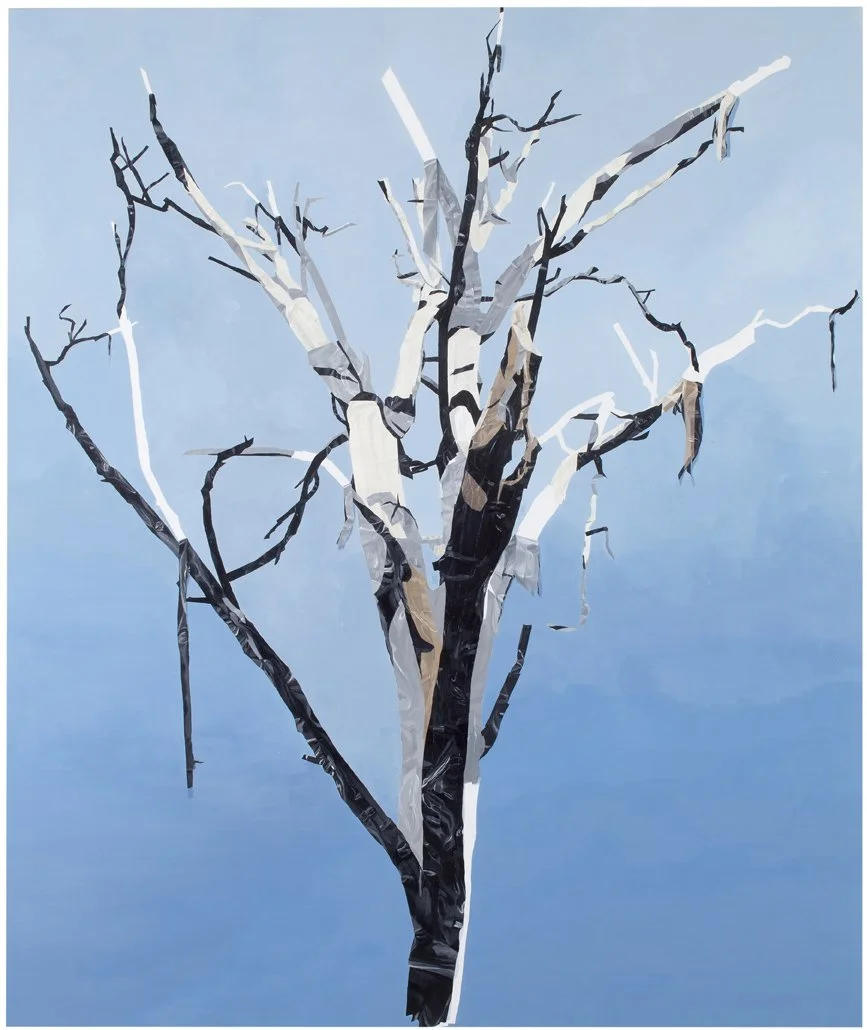Vanitas Series 2011-2014
Unmerged
Päivi Takala's paintings on the theme of vanity, with their flowing icebergs, torn trees, and collapsed monuments, hint at a lost landscape, the extinction of species, the loss of form, and the threat of catastrophe that escapes human scale. The mountain themes evoke the sublime sphere of early Romantic nature experiences, where the known pleasure of the landscape mingled with despair: "lost mountain, noble ruin" (Shaftesbury, The Moralists, 1709).
Takala's cut and glued, shredded and patched mountain peaks may refer to the melting of glaciers, but above all, they leak like a sieve: the subject, the presentation is cut from the base, through the image surface. The landscape props resemble a cut stencil, a serigraph sieve. The landscape becomes a cliché, a printing surface, a reproducible turning surface. The works also refer to the development of photography or the opening frame of a film, the cutting of film strips and montage (Paramount). The backdrop detaches from the fabric background, the painting's curtains fall, the presentation flows from its frames, the subject disappears.
The works Illusion, Figure, Portrait embody the history of painting from the 19th to the 20th century: how the traditional genres of painting, such as portrait and landscape, are wiped away as the traditional purpose of painting, the idea of the image as likeness and imitation, crumbles with the advent of industrial reproduction techniques. Tape, the painter's tool, an aid for precise perception, a support for illusion, tears away from the background. The painter's working process is inscribed in the tape as a gripping surface for the audience, but the outlines of the human figure peel away, the conveyed message fades, just like the dim object itself.
The Tatlin and Cross painting series evoke the utopias of modernism. Tatlin's cast-iron idea of the Monument to the Third International flows, and the black crosses referencing Malevich's painting peel away from the white background. Both constructivists and suprematists believed that painting would end by merging it with life, social planning, and architecture. The task of art was, for example, to structure a common, shared way of living through design. space, to grasp the shape of the common, to create a concrete form of community, a way of life. The loose tapes and sticker films from Takala's paintings detach from these "social plastics", completed, goal-oriented projects. Conversely, they ask whether art can hold any critical place in the present, to make space for the unassimilated, the unsolvable.
Inkamaija Iitiä
Vanitas series, 2011, Galerie Anhava
photo: Jussi Tiainen
Vanitas Series (Tatlin on white), 2011, 250 x 200 cm, oil on canvas, Hämeenlinna Art Museum, Hämeenlinna
photo: Jussi Tiainen
Vaanitas Series Tatlin on black), 2011, 250 x 200 cm, oil on canvas, Heino Collection, HAM, Helsinki
photo: Jussi Tiainen
2015 Galerie Anhava
photo: Jussi Tiainen
Vanitas Series, Grid, 2015, oil on canvas, 2x2m, Kiasma
photo: Jussi Tiainen
Vanitas Series, 2011, Galerie Anhava
photo: Jussi Tiainen
Vanitas Series (tree), 2011, 180x 140cm, oil on canvas, Saastamoinen Foundation collection, Emma, Espoo
photo: Jussi Tiainen







